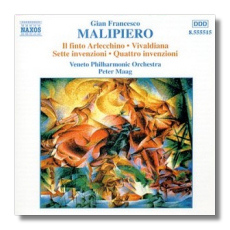
The Internet's Premier Classical Music Source
Related Links
- Latest Reviews
- More Reviews
-
By Composer
-
Collections
DVD & Blu-ray
Books
Concert Reviews
Articles/Interviews
Software
Audio
Search Amazon
Recommended Links
Site News
 CD Review
CD Review
Gian Francesco Malipiero

Orchestral Works
- Inventions
- Symphonic Fragments from "Il Finto Arlecchino"
- Vivaldiana
Veneto Philharmonic Orchestra/Peter Maag
Marco Polo 8.223397 - 63min


Reissued on Naxos 8.555515
Stylistically, Malipiero comes between Puccini and Respighi – he was born just three years after the latter, in 1882. With Puccini he shared an interest in oriental melodies (note Invention XI), and like Respighi he could write brilliantly for the orchestra (the swirling mid-section of Invention III evokes the Fountains of Rome).
The Inventions were written for Walter Ruttmann's film Steel. Only a portion of Malipiero's score was used in the final product, prompting the composer to prepare these two brief suites. The Seven Inventions begin and end with strident, mildly dissonant outbursts which were intended to accompany images of a steel foundry. No doubt they would be more effective in their original context. In any event, both Prokofieff and Mosolov were infinitely better at that sort of thing. In spite of the lively rhythms of V, nothing much happens in between. Conductor Maag shares some of the blame for the blandness of the proceedings, and the thin, reedy string section of the Veneto ensemble doesn't help matters. The remaining suite of Four Inventions depicts scenes of rustic village life. The delicate scoring and bitonality sounds more French than Italian. Indeed, I was reminded strongly of Milhaud's Suite Provençale, though Malipiero's thematic material is far less interesting. IV makes inventive and colorful use of pianos with percussion. Otherwise there is little to hold one's interest.
The four fragments from Il Finto Arlecchino are the shortest, yet most musically substantial items in this collection. The 1925 opera from which they are drawn was set in 18th century Venice, and the music evokes that far away time. Here we have a delightful succession of pretty melodies dressed up in rich orchestral garb. The Veneto orchestra turns in a lively, winning performance, and the strings don't sound nearly as unpleasant in this instance. Perhaps a different microphone set-up was used.
In addition to his work as a composer, Malipiero was a musicologist who devoted himself to producing scholarly editions of the works of his predecessors, such as Monteverdi, Cavalieri, and Galuppi. His editorial research into Vivaldi's scores inspired him to produce Vivaldiana, based on excerpts from that composer's concertos. What prompted him to select six of the Red Priest's most monotonous and undistinguished ideas is anyone's guess. The result is "generic" Vivaldi, without the color, vitality, or sparkle of the originals. The wiry Veneto strings are especially irritating here.
Copyright © 1996, Tom Godell


















